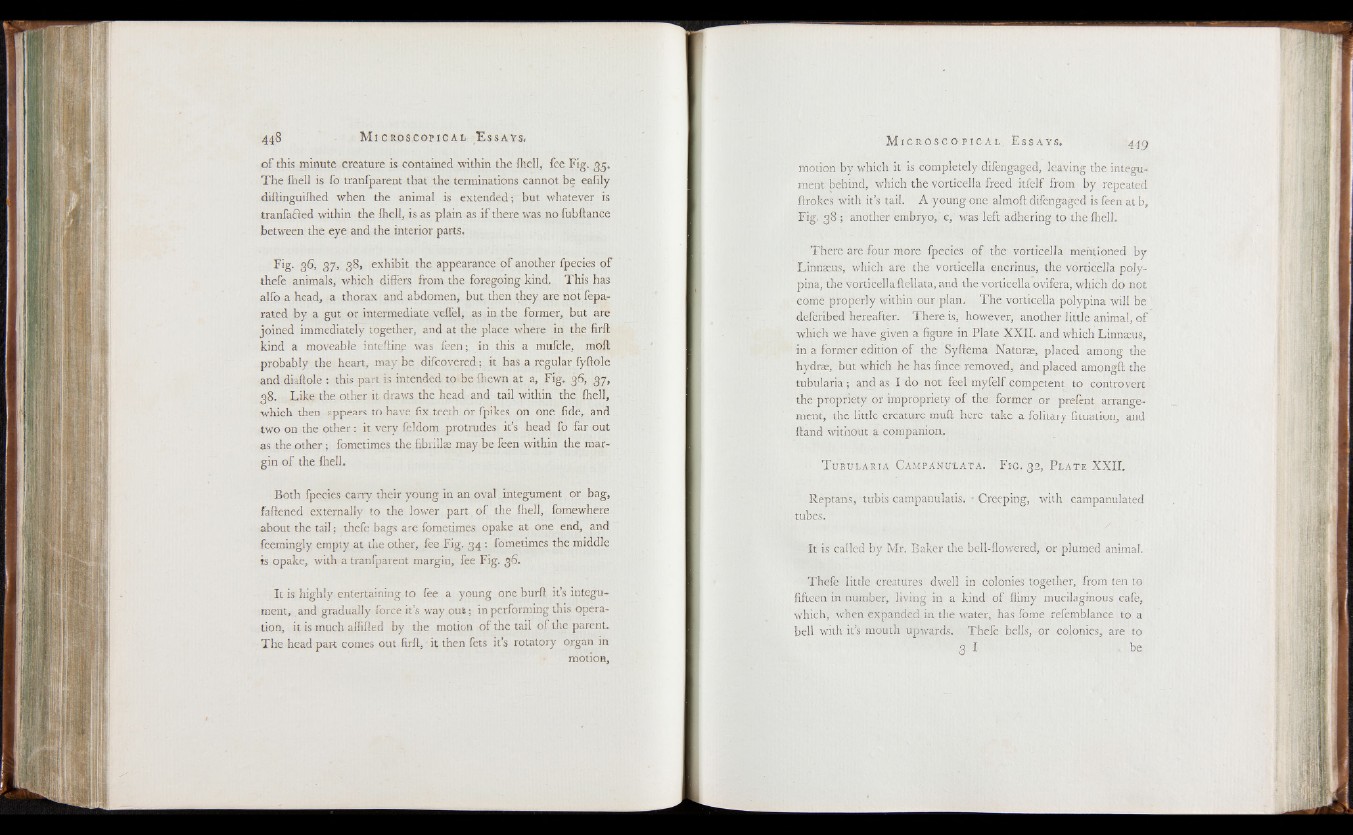
448 M i c r o s c o p i c a l E s s a y s .
o f this minute creature is contained within the fhell, fee Fig. 35.
The fhell is fo tranfparent that the terminations cannot be ealily
diftinguifhed when the animal is extended; but whatever is
tranfafted within the fhell, is as plain as if there was no fubftance
between the eye and the interior parts.
Fig- 36, 371 38, exhibit the appearance o f another fpecies of
thefe animals, which differs from the foregoing kind. This has
alfo a head, a thorax and abdomen, but then they are not fepa-
rated by a gut or intermediate veffel, as in the former, but are
joined immediately together, and at the place where in the firft
kind a moveable inteftine was feen; in this a mufcle, mod
probably the heart, may be difcovered; it has a regular fyftole
and diaftole : this part is intended to be Ihewn at a, Fig. 36, 37,
38. Like the other it draws the head and tail within the fhell,
which then appears to have fix teeth or fpikes on one fide, and
two on the other: it very feldom protrudes it’s head fo far out
as the other; fometimes the fibrillas may be feen within the margin
o f the fhell.
Both fpecies carry their young in an oval integument or bag,
faftened externally to the lower part o f the fhell, fomewhere
about the tail; thefe bags are fometimes opake at one end, and
feemingly empty at the other, fee Fig. 34: fometimes the middle
is opake, with a tranfparent margin, fee Fig. 36.
It is highly entertaining to fee a young one burft it’s integument,
and gradually force it’s way ou t; in performing this operation,
it is much aflifted by the motion of the tail of the parent.
The head part comes out firft,' it then fets it’s rotatory organ in
motion,
M i c r o s c o p i c a l . E s s a y s . 449
motion by which it is completely difengaged, leaving the integument
behind, which the vorticella freed itfelf from by repeated
ftrokes with it’s tail. A young one almoft difengaged is feen at b,
Fig. 38 ; another embryo,' c, was left adhering to the fhell.
There are four more fpecies o f the vorticella mentioned by
Linnaeus, which are the vorticella encrinus, the vorticella poly-
pina, the vorticella ftellata, and the vorticella ovifera, which do not
come properly within our plan. The vorticella polypina will be
defcribed hereafter. There is, however, another little animal, o f
which we have given a figure in Plate XXII. and which Linnaeus,
in a former edition of the Syftema Naturae, placed among the
hydrae, but which he has fince removed, and placed amono-ft the
tubularia ; and as I do not feel myfelf competent to controvert
the propriety or impropriety o f the former or prefent arrangement,
the little creature muft here take a folitary fituation, and
ftand without a companion.
T ubularia CampAnulata. Fig. 32, Plate XXII.
Reptans, tubis campanulatis. • Creeping, with campanulated
tubes.
It is called by Mr. Baker the bell-flowered, or plumed animal.
Thefe little creatures dwell in colonies together, from ten to
fifteen in number, living in a kind o f flimy mucilaginous cafe,
which, when expanded in the water, has fome refemblance to a
bell with it’s mouth upwards. Thefe bells, or colonies, are to
3 I . b e